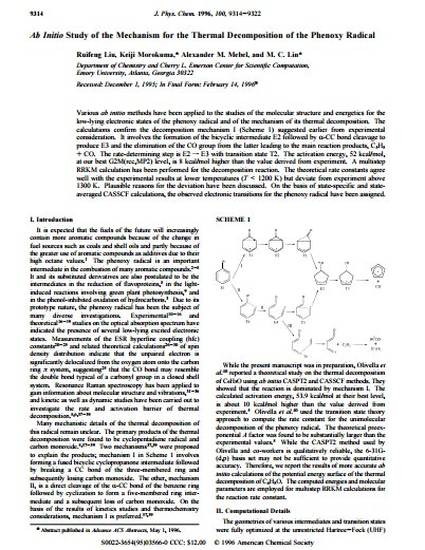
Article
Ab Initio Study of the Formation and Degradation Reactions of Semiquinone and Phenoxyl Radicals
Journal of Molecular Structure: THEOCHEM
(2008)
Abstract
Calculations of the energetics of formation, stability, and reactivity of o-semiquinone, p-semiquinone, and phenoxyl radicals have been performed using B3LYP/6-31G(d,p), BHandHLYP/6-31G(d,p), BHandHLYP/6-311++G(d,p), BHandHLYP/aug-cc-pVDZ, and QCISD(T)/6-31G(d,p)//BHandHLYP/6-31G(d,p) model chemistries. Formation of these radicals from potential molecular precursors catechol, hydroquinone, and phenol is readily achieved under combustion conditions through unimolecular scission of the phenoxyl–hydrogen bond or abstraction of the phenoxyl hydrogen by a hydrogen atom or hydroxyl radical. The resulting radicals are resonance stabilized and resist decomposition and oxidation. Activation energies for the decomposition of the radicals through concerted elimination of carbon monoxide range from ≈55 to 75 kcal/mol. Activation energies for the addition of molecular oxygen to the most reactive carbon atom (in all cases at the para-position) range from ≈8 to 22 kcal/mol. The calculations strongly suggest that combustion-generated semiquinone and phenoxyl radicals are sufficiently stable and resistant to oxidation to be persistent in the atmospheric environment.
Keywords
- Ab initio,
- Quinone,
- Free radical
Disciplines
Publication Date
January, 2008
Citation Information
Randall W. Hall, Cheri A. McFerrin and Barry Dellinger. "Ab Initio Study of the Formation and Degradation Reactions of Semiquinone and Phenoxyl Radicals" Journal of Molecular Structure: THEOCHEM Vol. 848 Iss. 1-3 (2008) p. 16 - 23 ISSN: 0166-1280 Available at: http://works.bepress.com/randall_hall/5/
